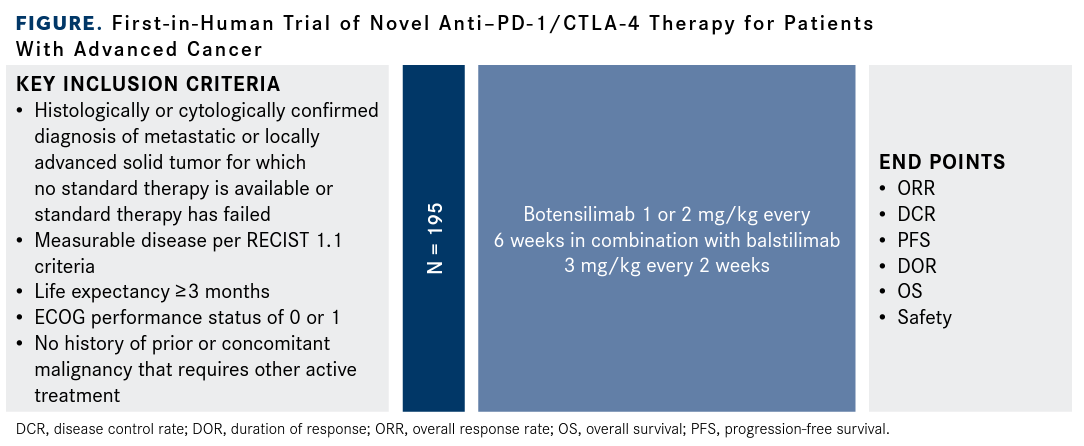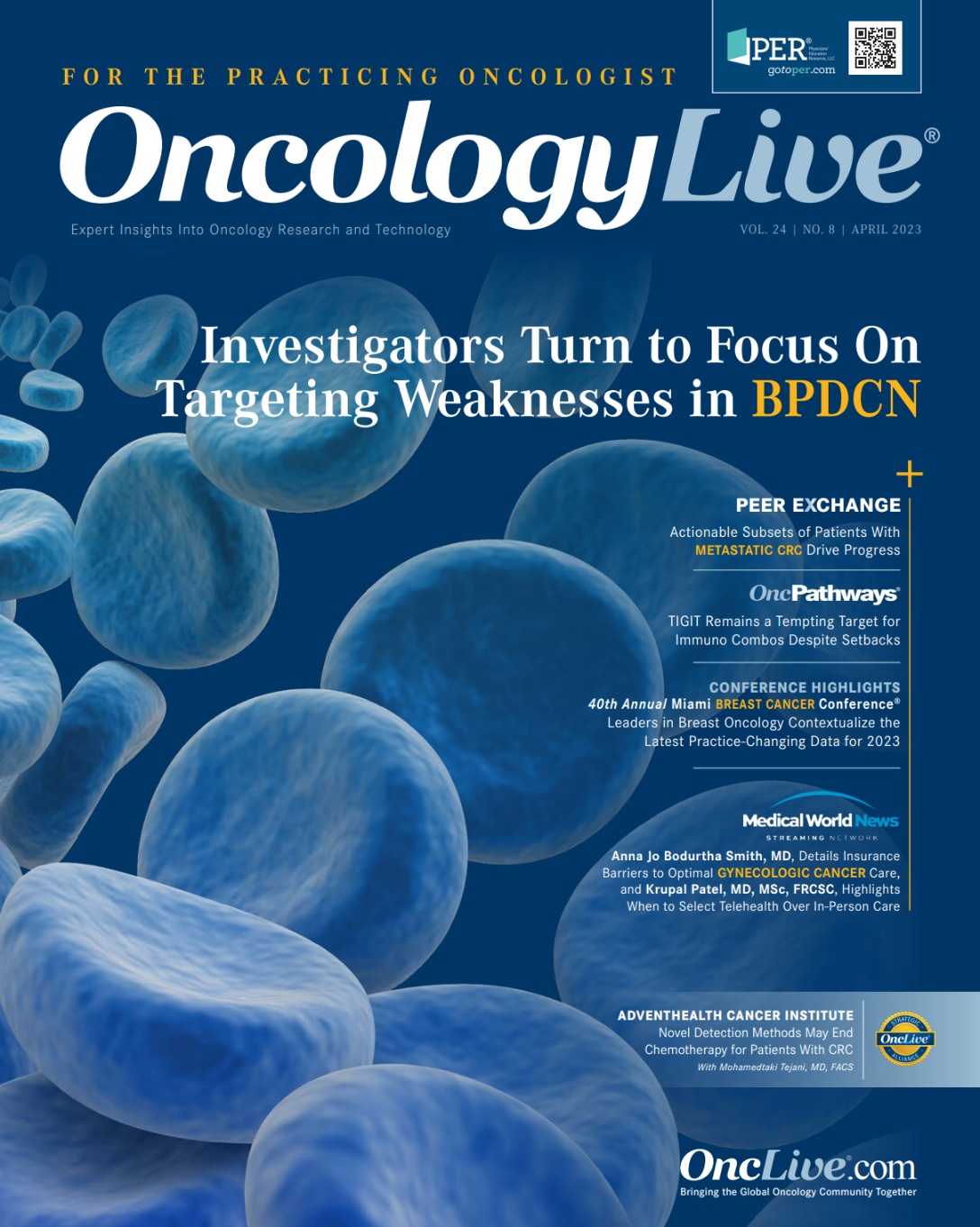PD-1/CTLA-4 Combination Drives Progress Across Tumor Types
Investigators of an ongoing phase 1a/1b multicohort trial are studying whether addition of adaptive immune activators increases the benefit derived from anti–PD-1 antibodies in multiple tumor types.
Bruno B. Bockorny, MD

Immunotherapy has been unsuccessful in advanced solid tumors refractory to standard therapy, including PD-1 and CTLA-4, because of hostile tumor microenvironments. Thus, these types of patients with sarcomas and lung, ovarian, and gastrointestinal carcinomas represent a significant unmet need in this space.
The tide has begun to change, however, with the advent of a novel combination that can penetrate cold and immunotherapy-refractory tumors. Investigators of an ongoing phase 1a/1b multicohort trial (NCT03860272) are studying whether addition of adaptive immune activators increases the benefit derived from anti–PD-1 antibodies (Figure).1
The backbone therapy for the trial is balstilimab, a PD-1 inhibitor previously submitted for FDA approval in the setting of recurrent metastatic cervical cancer that demonstrated single-agent efficacy with up to 20% response in a total of 140 patients with PD-L1–positive and PD-L1–negative disease.2 Balstilimab has also shown synergistic potential when combined with the CTLA-4 inhibitor zalifrelimab, resulting in an objective response rate (ORR) of 25.6% in 125 patients with recurrent or metastatic cervical cancer who relapsed after platinum-based therapy.3
Botensilimab, a novel innate adaptive immune activator, is being investigated for its potential to improve the efficacy of immunotherapy in resistant tumors. “Botensilimab is a novel multifunctional CTLA-4 antibody designed to increase the benefits of immunotherapy…[in] patients with cold and resistant tumors,” Bruno B. Bockorny, MD, said in an interview with OncLive®.
“On the front end, botensilimab blocks CTLA-4 like other agents do, but on the back end, in the Fc portion, there are point mutations that increase the binding to the activating Fc gamma receptor on both antigen-presenting cells and natural killer [NK] cells. By doing that, we have a variety of unique benefits compared with the first-generation CTLA-4 [options]. We have a more substantial boost of the priming and memory formation of T cells and a more substantial depletion of the immunosuppressive T regulatory cells.” Bockorny is an assistant professor of medicine at Harvard Medical School and a medical oncologist and cellular biology researcher at Beth Israel Deaconess Medical Center, both in Boston, Massachusetts.
Over the past year, the combination has elicited promising results in patients with resistant/ refractory ovarian cancer and with microsatellite stable (MSS) colorectal cancer (CRC).4,5
Strides in Ovarian Cancer
Bockorny noted that there are few options for patients with resistant/refractory ovarian cancer and that response rates are usually less than 10% with single-agent chemotherapies and investigational immunotherapy combinations. At the 2023 Society of Gynecologic Oncology Annual Meeting on Women’s Cancers, however, data from the cohort of patients with resistant/refractory ovarian cancer showed durable responses.4
Figure. First-in-Human Trial of Novel Anti–PD-1/CTLA-4 Therapy for Patients With Advanced Cancer

Among 24 patients, the doublet elicited an overall response rate of 33% (95% CI, 15.6%-55.3%), which included 1 (4%) complete response (CR) and 7 (29%) partial responses (PR). Eight patients achieved stable disease, and 8 others experienced disease progression. At a median follow-up of 6.9 months (range, 1.7-29.2), the median duration of response (DOR) was not reached (NR; 95% CI, 4.2-NR). The disease control rate (DCR) was 67% (95% CI, 44.7%-84.4%).4
“We were very encouraged because, aside from deep responses, the responses were also very durable,” Bockorny said. “We had multiple patients [experience] very prolonged clinical benefits, either disease stabilization or responses.”
He added that with such a small patient population, investigators could not identify a biomarker that separated responders from nonresponders. “We are looking at, for instance, PD-1 as a potential marker; [however,] in this limited analysis of 24 patients, we are seeing that both patients with PD-1 [expression] are responding, but also [that those without] PD-1 expression are… responding.” Enrollment in the trial is ongoing.
Patients with platinum-resistant or refractory, metastatic disease received 1 mg/kg (29%) or 2 mg/kg (71%) of botensilimab every 6 weeks plus 3 mg/kg of balstilimab every 2 weeks. Patients were allowed to have received prior immunotherapy, and crossover from prior botensilimab monotherapy was allowed.
Median patient age was 64 years (range, 37-75). Fourteen patients (58%) had an ECOG performance status of 0, and the remaining 10 (42%) had a status of 1. Bockorny noted that this was a very heavily pretreated cohort, with a median of 4 (range, 1-8) prior therapies. Nineteen patients (79%) had previously received bevacizumab (Avastin) and 5 (21%) had received immunotherapy.
In terms of histology, 19 patients (79%) had high-grade serous disease, 1 (4%) had carcinosarcoma, and 2 (8%) each had mixed (clear cell/ endometrioid) or clear cell disease. Two of 13 patients (15%) were BRCA1/2 positive, and 7 of 16 (44%) were PD-L1 positive.
Bockorny said the combination displayed a manageable toxicity profile. The rate of grade 3/4 treatment-related adverse effects (TRAEs) was 41%, and most of these (21%) were attributable to grade 3 immune-mediated diarrhea/colitis.4
Other TRAEs included nausea (all-grade, 33%; grade 3, 4%), vomiting (all-grade, 17%), fatigue (all-grade, 38%; grade 3, 4%), pyrexia (all-grade, 25%), rash (all-grade, 33%; grade 3, 4%), pruritus (all-grade, 33%), and arthralgia (all-grade, 21%).4
“What’s particularly important for this safety profile is [that] we did not have any treatment-related deaths,” Bockorny said. “Importantly, we do not have any pneumonitis, hypophysitis, or myocarditis of any grade. It’s very consistent with the larger data sets of botensilimab and balstilimab, [in which] we see very little high-grade visceral toxicity outside of the [gastrointestinal] tract. That was an important safety point, and we were pleased to see that.”
Advances Lead to Phase 2 Development for MSS CRC
In the cohort of patients with MSS CRC (n = 70), median follow-up was 7 months (range, 2-31) and objective response rate, 23% (95% CI, 14%-34%). One CR was reported (1%), 15 patients had PR (21%), and most (53%) had stable disease. The disease control rate (DCR) was 76% (95% CI, 64%-85%). At the time of analysis, median overall survival (OS) had not been reached, and median progression-free survival was 4.1 months (95% CI, 2.8-5.5). The 12-month OS rate was 63% (95% CI, 45%-76%).5
Among the 16 patients who responded, 11 continued to experience response at the time of data cutoff.5 Additional characteristics for these patients included refractory to prior immunotherapy (3 patients), tumor mutational burden data available (1 of 13), greater than 10/mut/Mb, and positive PD-L1 data of 1% or higher (1 of 8).5
“In the past, conventional checkpoint inhibitors have been universally ineffective in MSS CRC,” Benjamin L. Schlechter, MD, said in an interview with OncLive. “The CTLA-4 antibody [of botensilimab], which is modified to decrease complement fixation and increase NK cell activation, hopefully can improve the safety profile and…the activity of the drug. We observed responses in patients with nonhepatic CRC [and] that’s a significant minority [of patients].” Schlechter is a senior physician at DanaFarber Cancer Institute and an instructor in medicine at Harvard Medical School, both in Boston, Massachusetts.
“The safety profile was manageable. There was a lot of colitis, but that’s something we [can handle]. This is the first—in a phase 1—significant response rate in colorectal cancer for MSS diseases using checkpoint inhibitor therapy, which is important.”
Ninety-one percent of patients reported TRAEs of any grade, 40% reported grade 3 events, and 3%, grade 4 events. As Schlechter noted, the only grade 3/4 TRAEs to occur in more than 3 patients were diarrhea and colitis, with 20% of patients experiencing grade 3 events and 1%, grade 4 events. No grade 5 events were reported.5
The combination had greater efficacy in patients without hepatic disease. Among those with-out active liver metastases, median OS was not reached and 12-month OS was 81% (95% CI, 66%-90%), whereas among those with active liver metastases, median OS was 9.4 months (95% CI, 6.1-NR), and 12-month OS, was 40% (95% CI, 17%-62%).5
“[There was] significant disease control for patients with nonhepatic disease in refractory CRC, a population who would otherwise be receiving agents that have had very limited efficacy,” Schlechter said. “It was noted early on that patients with nonhepatic disease were deriving benefits and those with hepatic disease were not, and this is a known problem. We’ve known for a while that bulky hepatic metastasis, even in so-called hot tumors, have less of a response and that metastatic disease and liver [disease] have a worse response to checkpoint inhibitors, so it’s not shocking that this is happening.”
As was the case with the ovarian cancer cohort, in this analysis patients received botensilimab at either 1 or 2 mg/kg every 6 weeks plus balstilimab at 3 mg/kg every 2 weeks. Patients were eligible to crossover from monotherapy to combination therapy or to fixed dosing of botensilimab 150 mg every 6 weeks plus balstilimab 450 mg every 3 weeks.5
Schlechter added that the responses translated to a greater than 30% reduction in cancer burden. “There were patients with near-complete responses. So essentially all measurable disease, as far as we can tell, had been suppressed and the survival was prolonged…. Again, this is a population of patients with refractory CRC…[in whom] we measure responses usually in weeks, and survival…[in] weeks or a few months. To have a population of patients where the median survival is not met is impressive in a large phase 1 study.”
A phase 2 and phase 3 study are planned for this cohort of patients, and the phase 2 portion is actively enrolling patients (NCT05608044).6 “There are going to be some dosing schedule assessments in phase 2, and there will be a standard-of-care control arm against [trifluridine/tipiracil (Lonsurf)] or regorafenib [Stivarga]. That’s an important step to lead to approval of the drug,” Schlechter said.
The trial will have 5 cohorts: Two will evaluate the combination of botensilimab and balstilimab with 2 different doses of botensilimab, 2 will evaluate botensilimab as monotherapy at 2 doses, and the fifth will be standard of care.6
In terms of next research steps, Schlechter added, “We also need to figure out ways to manage patients with active metastatic liver disease. I think the race is on to figure out why patients with active metastatic disease in the liver don’t respond to checkpoint inhibitors generally, and this combination [in particular].… [We must] expand the population that’s eligible for this trial from 25% to 30% of all patients with refractory disease to 100%, or nearly 100%. Those are important areas of research, and we [will] see a lot about that over the next 2 years.”
Additional Efficacy Signals: Sarcoma, NSCLC
Durable responses were also seen in smaller subsets of patients treated with balstilimab plus botensilimab.
At the 2022 Connective Tissue Oncology Society Annual Meeting, investigators presented results from the cohort of patients with refractory sarcoma (n = 13). The ORR was 46% (95% CI, 19%-75%), with 1 patient having a CR and 5 (38%), a PR. Stable disease was reported among 23% of patients, and the DCR was 69% (95% CI, 39%-91%). The median DOR and median OS were NR, and the 12-month OS rate was 77% (95% CI, 35%-94%).7
Responses were ongoing in 4 of 6 patients at the time of data cutoff. Among those with angiosarcoma (n = 9), the ORR was 56%, with a DCR of 78%. The CR and 3 of the 4 ongoing responses were reported from this subgroup. Similar safety observations to the overall trial were reported, with no grade 4 or 5 events in this cohort.7
Finally, data presented at the Society for Immunotherapy of Cancer 37th Annual Meeting & Preconference Programs showed that in patients with non–small cell lung cancer who received the combination (n = 4), the ORR was 50% (95% CI, 7%-93%), and both responses were PRs. The DCR was 75% (95% CI, 19%-99%), and the median DOR was NR. Both patients with an ORR had been previously treated with pembrolizumab (Keytruda), and response was ongoing in 1 patient.8
References
- Fc-engineered anti-CTLA-4 monoclonal antibody in advanced cancer. ClinicalTrials.gov. Updated September 22, 2022. Accessed March 29, 2023. https://clinicaltrials.gov/ct2/show/NCT03860272
- Agenus provides update on balstilimab development. News release. Agenus. October 22, 2021. Accessed March 29, 2023. bit.ly/3M9anjA
- O’Malley DM, Neffa M, Monk BJ, et al. Dual PD-1 and CTLA-4 checkpoint blockade using balstilimab and zalifrelimab combination as second-line treatment for advanced cervical cancer: an open-label phase II study. J Clin Oncol. 2022;40(7):762-771. doi:10.1200/JCO.21.02067
- Bockorny B, Matulonis UA, O’Day SJ, et al. Botensilimab, a novel innate/adaptive immune activator, plus balstilimab (anti–PD-1) in patients with recurrent platinum refractory/resistant ovarian cancer. Presented at: 2023 Society of Gynecologic Oncology Annual Meeting on Women’s Cancer; March 25-28, 2023; Tampa, FL.
- El-Khoueiry AB, Fakih M, Gordon MS, et al. Results from a phase 1a/1b study of botensilimab (BOT), a novel innate/adaptive immune activator, plus balstilimab (BAL; anti-PD-1 antibody) in metastatic heavily pretreated microsatellite stable colorectal cancer (MSS CRC). J Clin Oncol. 2023;41(suppl 4):LBA8. doi:10.1200/JCO.2023.41.4_suppl.LBA8
- A study of botensilimab and balstilimab for the treatment of colorectal cancer. ClinicalTrials.gov. Updated December 20, 2022. Accessed March 29, 2023. https://clinicaltrials.gov/ct2/show/NCT05608044
- Wilky BA, Moser JC, Gordon MS, et al. A phase Ia/Ib study of botensilimab, a novel innate/adaptive immune activator, plus balstilimab for the treatment of patients with sarcoma. Presented at: 2022 Connective Tissue Oncology Society Annual Meeting; November 16-19, 2022; Vancouver, British Columbia, Canada.
- Wilky B, El-Khoueiry A, Bullock A, et al. Botensilimab, a novel innate/adaptive immune activator, plus or minus balstilimab (anti-PD-1) in “cold” and I-O refractory metastatic solid tumors. J Immunother Cancer. 2022;10(suppl 2). doi:10.1136/jitc-2022-SITC2022.0778




